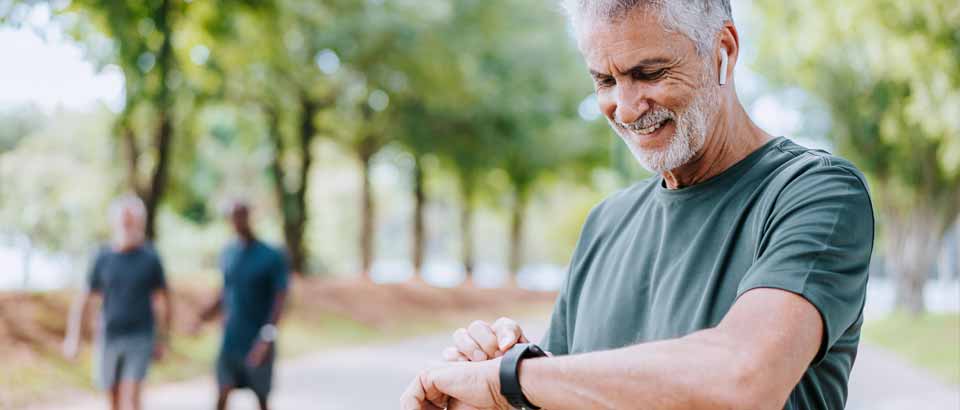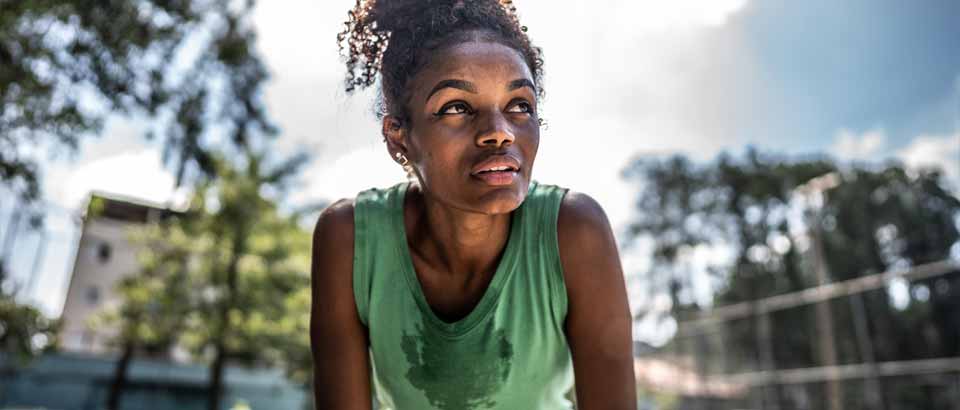August 12, 2024
With hot weather comes the opportunity to work out and play sports outside. Sure, all that sun and warm weather feels good and can be a real motivator. However, there are also some health risks to keep in mind. Here are ten new ways that you can get the most out of the season in the safest and healthiest ways possible.

1. Check In with Your Health Coach.
By that, we mean your medical provider. Before you start a new exercise routine or decide to do more workouts in the heat, speak with them and see if they have any concerns. This is extremely important if you have diabetes, heart disease or are managing any other chronic health risk.1
If you’re currently taking ace receptor blockers, ace inhibitors, beta blockers, calcium channel blockers or diuretics, these medications can change how your body responds to high temperatures. If you have any concerns, speak with your medical provider or pharmacist.1
2. It Isn’t Just What You Eat. It’s When.
Your body needs fuel to move. We all know that. But it also needs energy to digest your food, which creates body heat, which is the last thing you need when temperatures start to soar. Experts agree that if you want to eat before a workout, you should do so an hour before. However, if you choose a protein or fat-heavy meal, wait two to three hours so your body can fully digest it before you head out for a jog. Otherwise, your body will be devoting all its energy to breaking down that food instead of keeping you cool.2
Remember: Overindulging before a workout may cause lethargy, nausea, bloating and stomach discomfort. Those are symptoms no one wants to stomach in high heat.3
How long should you wait to have a meal after a workout under the sun? After all, eating protein, carbs and healthy fats can help your body rebuild after a workout faster, right? Experts believe that while you should hydrate before, during and after a workout, you shouldn’t snack for half an hour or eat for at least an hour after an outdoor workout. This helps your body get back to its normal temperature.2
3. Feeling the Heat? Change Your Routine.
When it’s too hot to even think about walking, much less jogging, there are still activities that can get you outside and moving. Low-impact yoga and pilates are also a great choice, but if you want to both cool down and get exercise, you can’t beat swimming.
If your body isn’t great with exercise when it gets hot and muggy, there are still ways to keep moving. Don’t feel like you need to be sweating it out on the pickleball court or the track if it’s going to exhaust you. Instead, you can try some light gardening (330 calories an hour), do some stretches (90 calories in just half an hour) or play a round of golf (330 calories an hour), you can still stay active and enjoy the benefits of exercise.
4. Work Smarter, Not Harder.
High Intensity Interval Training (HIIT) is a more time-efficient form of exercise that will help you get plenty of movement in just thirty minutes or less instead of an hour under the hot sun. HIIT may provide some unique health benefits, including burning a lot of calories in a short time, increasing your metabolism and possibly reducing blood sugar, heart rate and blood pressure.5

5. Know Your Limits.
Even when you are working out or playing sports in the best of conditions, your body is still working hard. Add in heat, sweating and humidity and you start to put stress on your heart.
As for seniors and young children, their bodies aren’t as good at adjusting to high temperatures. Older people may also be dealing with an existing health condition like diabetes or heart disease that further limits their ability to handle summer temperatures.6
That’s why the best course of action is to not just be aware of your limits and fitness level, but to ease up in the heat. Yes, competition is one thing. But unless you’re playing pro ball, just take it easy and chill out when you need to.
MedExpress Pro Tip: It’s a good idea to know the symptoms and how to treat heat exhaustion, particularly if you play or coach team sports.
6. Know Your Cooling Points.
When the heat is on, the same places that you check your pulse are also the perfect spots to target when it’s time to reduce your body’s temperature. Applying a cool towel to your wrists, arms and the back of your neck can reduce how hot you are and make it easier for your system to lower your overall body temperature.7
7. Dress Right for the Occasion.
Choose athletic clothing made with sweat-wicking breathable fabrics to stay cool as you sweat. When the heat Is on, the best choices are lightweight and loose-fitting clothes. Instead of dark colors that soak up the sun, choose lighter tones.
Another way to stay cool is to expose your skin. This will allow sweat to evaporate more easily. And, as if we had to tell you, don’t forget to protect yourself from the sun with sweat-proof sunscreen, a hat and sunglasses.8
8. They Call It a Dry Heat.
Knowing the difference between dry and humid heat can make all the difference in your summer workouts. In dry heat, your sweat can evaporate at a higher rate. However, in more humid climates, you won’t visibly sweat as much. That may mean that you won’t realize how much water you’ve lost. Never forget to keep properly hydrated.9
If your area only has high humidity, keep in mind that it adds extra stress on your body beyond just the temperature. That’s because humidity causes the air around us to become saturated with water vapor. As a result, sweat will keep dripping in the hopes of cooling off your body, continually producing more and more, making you feel more overheated.9
9. Be Well-Adjusted.
It’s important to realize that when summer starts, it might take up to ten days for your body to get used to high temperatures.10 That means that you should gradually increase how often and how intensely you play or work out in the great outdoors.
If you are coaching children in a sport this summer, their first practices should be low impact. Slowly increase how hard everyone practices as they get acclimated to the heat. Don’t forget to ensure that they’re properly hydrated. Wondering how you can do that if they hate drinking water? We have some ideas.
10. Be Your Own Trainer.
Major league athletes have trainers Ready to make sure that their bodies are staying healthy. You might not be able to afford a 24/7 sports medicine expert, but you can watch out for your body with a few tips for these summer sports:
- Tennis: As with all sports, you should warm up before you play. Tennis, however, uses specific muscles that you may not otherwise work out during the rest of the year. Have you ever heard of tennis elbow? To avoid it, try to limit how many swings you take every day and that your racquet is properly fitted.
- Golf: Much like tennis, there is also golf elbow. To protect yourself from this injury, try to relax your grip and ensure that your clubs are fitted before the start of the season.
- Walking and Running: Check your running shoes at least once a week. If you’re wearing down your soles or have a hole in your shoe, you’re going to put more strain on your ankles, knees, shins and hips. While we all know how important warming up is, don’t neglect the benefits of cooling down after you walk or run.
- Biking: To protect your knees, make sure that your bike seat is at the proper height. And to keep your back feeling its best, try to keep the natural curve of your spine while riding.
With all sports, remember that just like going to the gym, your body benefits from having rest days. And while you may be excited about training in great weather, remember to gradually increase the time and intensity of your workouts.
As you head outside and start your workout, always keep in mind that a little common sense goes a long way. If you’ve seen a health warning on the news about high heat and humidity or air quality, remember that you can always get your sweat on inside.
Here’s to a safe and healthy summer! Your neighborhood MedExpress is always here when you need us, whether you schedule a visit online or walk in from 8 to 8. From sprains to strains and whatever else the season brings, we’re ready to get you back on your feet and enjoying the great outdoors.
Originally published June 2024. Updated August 2024.
References:
1 American Health Association. How to Be Active Safely in Warm Weather. Last updated January 12, 2024. Accessed April 24, 2024.
2 Healthline. How Much Time Should I Leave Between Eating and Working Out? Last updated March 10, 2021. Accessed April 24, 2024.
3 Healthline. Post-Workout Nutrition: What to Eat After a Workout. Last updated March 14, 2023. Accessed April 24, 2024.
4 CDC. Physical Activity and Your Weight and Health. Last updated December 27, 2023. Accessed August 12, 2024.
5 Healthline. 7 Benefits of High Intensity Interval Training (HIIT). Last updated March 15, 2023. Accessed April 24, 2024.
6 CDC. Heat and Older Adults (Aged 65+). Last updated February 13, 2024. Accessed August 12, 2024.
7 National Library of Medicine / National Center for Biotechnology Information. Cooling the Neck Region During Exercise in the Heat. Accessed April 24, 2024.
8 American Heart Foundation. How to Be Active Safely in Warm Weather. Last updated January 12, 2024. Accessed April 24, 2024.
9 The Conversation. How to exercise in the summer without heat exhaustion. Accessed April 24, 2024.
10 The Conversation. How to train your body for hot weather if you are active or work outdoors. Accessed April 24, 2024.
